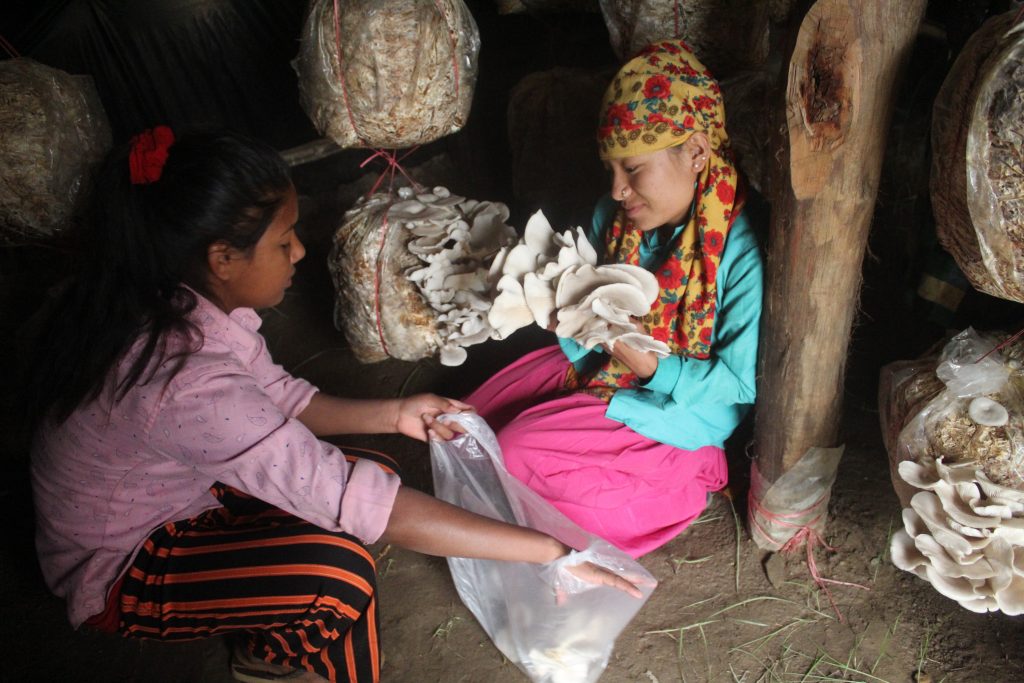




The livelihoods of the Chepangs of Kailash Rural Municipality depend on agricultural and physical labour they do at the nearest markets and towns.
In addition, they still rely on their surrounding forests and ecology for food, such as wild tubers, fruits, animals and fish. Unfortunately, the involvement of Chepangs in subsistence farming allows them to have food for six months only (Baseline Survey Report 2015).
So as part of an agricultural intervention, SDA has been working to grow agricultural literacy through demonstrative knowledge. Time and again, SDA introduces practical training and techniques for organic, seasonal and off-seasonal and commercial farming to the local farmers and provides them with seeds.
Shangri-La Development Association (SDA) procured a land of 52 Katha to demonstrate different components of simple agro-livestock technology (SALT-2) by which 2 VDCs – Kalikatar and Bharta of Makwanpur district will take benefit.
52 Katha farmland of SDA, nearly 17610 m2, is separated into three sections for performing different agricultural activities.
Block A: Agricultural Block uses 40% of the total land, which covers the following sub-blocks:
People Block: This block is for engaging the local farmer groups for training, and students of the hostel produce their products for daily consumption.
Demonstration block: This block is for the SDA experts to use as a demonstration area to the local farmers by introducing the new technology, methods of cultivation, and a variety of crops.
Block B: Livestock block uses another 40% of the total land.
Block C: Agroforestry block covers 20% of the land. Different types of trees such as leptocephali, Tik and Thayer, and Dudhilo are promoted here, along with the plantation of Paulownia.
Objectives of the Agriculture Project
To increase the product and productivity of agriculture and livestock products.
To make agriculture and livestock products competitive and commercial.
To reduce the negative impact of climate change and develop and distribute eco-friendly agricultural technology.
To protect and conserve agricultural biodiversity for the enhancement of business planning.
In addition to farming,
SDA also does breeding stock of goats in the established goat barn. Experts demonstrate sustainable use of land farm management, livestock management and agroforestry to the locals. SDA has used 500 Square metres of farmland for vegetable cultivation practice and demonstration purposes.
Agriculture is one of the main pillars of the multifaceted strategy to fight against malnutrition in Makwanpur. SDA has set the long-term direction of farm management strategy and has full right to take the help of DADO-M and SA/GA and its reliable agricultural exports in the long run.
Opportunities for the locals to work in the People Block of SDA farmland are provided time and again. The products go to the local schools through mid-day meals to local villagers as compensation for their labour.
SDA has adopted socioeconomic and environment-friendly modules of using local resource materials to make farm management economic. Similarly, all agro-based approaches such as cropping patterns and plant selection of SDA are harmless to the environment.
An experienced local gardener and his family are involved in daily work. A social mobilizer experienced in agricultural projects provides logistic and managerial input and keeps a daily record of the farm and its products. SDA agriculture staff communicates with SDA Agriculturist via phone calls, reports changes and plans the activities.
The activities done in the agricultural land are viewed from western perspective by SA/GA agriculture experts, who then suggest possibilities. Such suggestions are implemented analysing the practicality.
The overall master plan, daily monitoring templates and monthly reporting templates are developed and explained to the mobilizers. The periodic monitoring and evaluation are done by SDA agriculturists, while the deworming and feeding of livestock are checked and balanced by JTA-V.
The government and its stability affect SDA agricultural plans either positively or negatively. The instruction and its policy, Agriculture development Strategy (ADS), developed in 2015 after the earthquake, promotes and encourages the farmers to imitate this project activity.
The locals may not be able to afford vegetable products because of their lower income. But we provide the products to the locals in subsidies.
SDA offers the products with subsidies to the livestock to the working farmers by handing over the improved breeds of nanny to the farmer’s group after the request letter from the agricultural farmers’ group.
SDA provides its vegetable products to the schools and takes the price of the products from the education mid-day meal project activity to overcome the input cost. The surplus product is sold to a nearby market at a market rate or from the field at farm gate price.
The new technology may substitute the traditional method, but proper orientation and awareness sessions are required if someone wants to replicate our farming methods. Interested farmers receive training in technology and practice.
The farmland under the agriculture project is one of the sustainable components of the Shangri-La Development Association.
Map of SDA Agricultural Land

